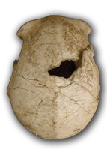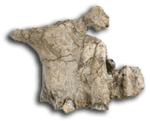 |  |
Whether they are mother-and-daughter species or two sisters, the relationship between Homo habilis and Homo erectus is becoming strained. A pair of discoveries near Lake Ileret in Kenya call into question the idea that H. erectus, the species from which modern humans evolved, is descended from H. habilis, the earliest hominid known to use stone tools.
A team of paleoanthropologists led by Meave and Louise Leakey of the Koobi Fora Research Project uncovered the upper jawbone of a H. habilis dated to 1.44 million years ago, and the skull of a H. erectus dated to 1.55 million years ago. H. habilis was thought to have gradually evolved into H. erectus over hundreds of thousands of years, fading out of existence around 1.65 million years ago. A previously discovered H. erectus fossil dated to 1.9 million years combined with the new finds show the two species lived together in the same lake basin for close to 500,000 years.
The discovery of a Homo habilis jawbone and a Homo erectus skull that are close in age has paleontologists rethinking the idea that H. habilis evolved into H. erectus. (National Museums of Kenya/Fred Spoor)
“I think increasingly they will be recognized as sister species that lived in the same area and did different things,” says Fred Spoor of University College London and a member of the team. H. erectus‘ smaller teeth and less powerful jaws suggest it was probably eating more meat. If the two species both evolved from a common ancestor, it changes the human race’s relationship to H. habilis. “Strictly speaking, if our scenario is correct,” says Spoor, “Homo habilis, as we know the species, seems to be a dead branch.”
For more interesting topics related to archaeology, visit archaeology excavations.
No comments:
Post a Comment